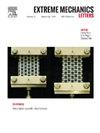针织物卷曲形态:结构与力学
IF 4.5
3区 工程技术
Q2 MATERIALS SCIENCE, MULTIDISCIPLINARY
引用次数: 0
摘要
针织物是将一维纱线拼接成三维曲线而形成的类二维结构。平针或短袜针是最基本的针织针法之一,由弯曲纱线的周期性晶格组成,其中三维卷曲行为自然出现在边缘。以往的研究主要是基于二维模型对针织物的弹性和几何形状进行研究。然而,三维几何与针织物力学之间的关系至今尚未得到明确。织物的卷曲行为与作用在纱线上的力和力矩、单位针织圈的几何形状、机械性能和接触密切相关,因此需要三维分析。在这里,我们结合桌面规模的实验和基于减少弹性的模拟,展示了平纹织物的卷曲是通过编织环的弹性和几何形状出现的。我们发现,通过改变水平和垂直编织数,出现了三种类型的卷曲形状:侧卷曲和上下卷曲形状,它们只在水平和垂直方向卷曲,以及双卷曲形状,这两种卷曲形状同时出现。我们发现,当针织环被垂直拉长时,织物是侧卷曲的,而当环被水平拉长时,我们观察到双卷曲,然后是上/下卷曲。此外,我们还发现这种特有的环形会影响针织物的力学性能。通过b样条曲线离散纱线的中心线形状,考虑弹性拉伸、弯曲和接触力学,通过纱线的力和力矩平衡来阐明复杂形状变形的基本机理。我们揭示了单线圈的三维结构在卷曲行为中起着关键作用。我们的研究结果表明,每一个针织环的形状变化有可能控制针织织物的三维自然整体形状。针织织物的三维卷曲行为对工业应用很有用,如复合材料、可穿戴设备和执行器。我们的发现可以应用于预测或设计更复杂的针织织物三维形状。本文章由计算机程序翻译,如有差异,请以英文原文为准。

Curling morphology of knitted fabrics: Structure and Mechanics
Knitted fabrics are two-dimensional-like structures formed by stitching one-dimensional yarn into three-dimensional curves. Plain stitch or stockinette stitch, one of the most fundamental knitting stitches, consists of periodic lattices of bent yarns, where three-dimensional (3D) curling behavior naturally emerges at the edges. The elasticity and geometry of knitted fabrics have been studied in previous studies, primarily based on 2D modeling. Still, the relation between 3D geometry and the mechanics of knitted fabrics has not been clarified so far. The curling behavior of knits is intricately related to the forces and moments acting on the yarns, geometry of the unit knitted loops, mechanical properties, and contacts, hence requiring a 3D analysis. Here, we show that the curling of plain knits emerges through the elasticity and geometry of the knitted loops, combining desktop-scale experiments and reduced elasticity-based simulations. We find that by changing the horizontal and vertical knitting numbers, three types of curl shapes emerge: side curl and top/bottom curl shapes, which are curled only horizontally and vertically, and double curl shape, in which both curl shapes appear together. We uncover that the knit is side-curled when the knitted loop is vertically elongated, while we observe double curl and then top/bottom curl as the loop becomes horizontally elongated. Furthermore, we find that this characteristic loop shape affects the mechanical properties of knitted fabrics. The fundamental mechanism of intricate shape deformation is clarified through the force and moment balance along yarn whose centerline shape is discretized through the B-spline curves, where elastic stretching, bending, and contact mechanics are taken into account. We reveal that the 3D structure of the single knitted loop plays a critical role in the curling behavior. Our results imply that the change in shape per a single knitted loop has the potential to control the 3D natural overall shape of knitted fabrics. The 3D curling behavior of knitted fabrics is useful for industrial applications such as composite materials, wearable devices, and actuators. Our findings could be applied in predicting or designing more complex 3D shapes made of knitted fabrics.
求助全文
通过发布文献求助,成功后即可免费获取论文全文。
去求助
来源期刊

Extreme Mechanics Letters
Engineering-Mechanics of Materials
CiteScore
9.20
自引率
4.30%
发文量
179
审稿时长
45 days
期刊介绍:
Extreme Mechanics Letters (EML) enables rapid communication of research that highlights the role of mechanics in multi-disciplinary areas across materials science, physics, chemistry, biology, medicine and engineering. Emphasis is on the impact, depth and originality of new concepts, methods and observations at the forefront of applied sciences.
 求助内容:
求助内容: 应助结果提醒方式:
应助结果提醒方式:


